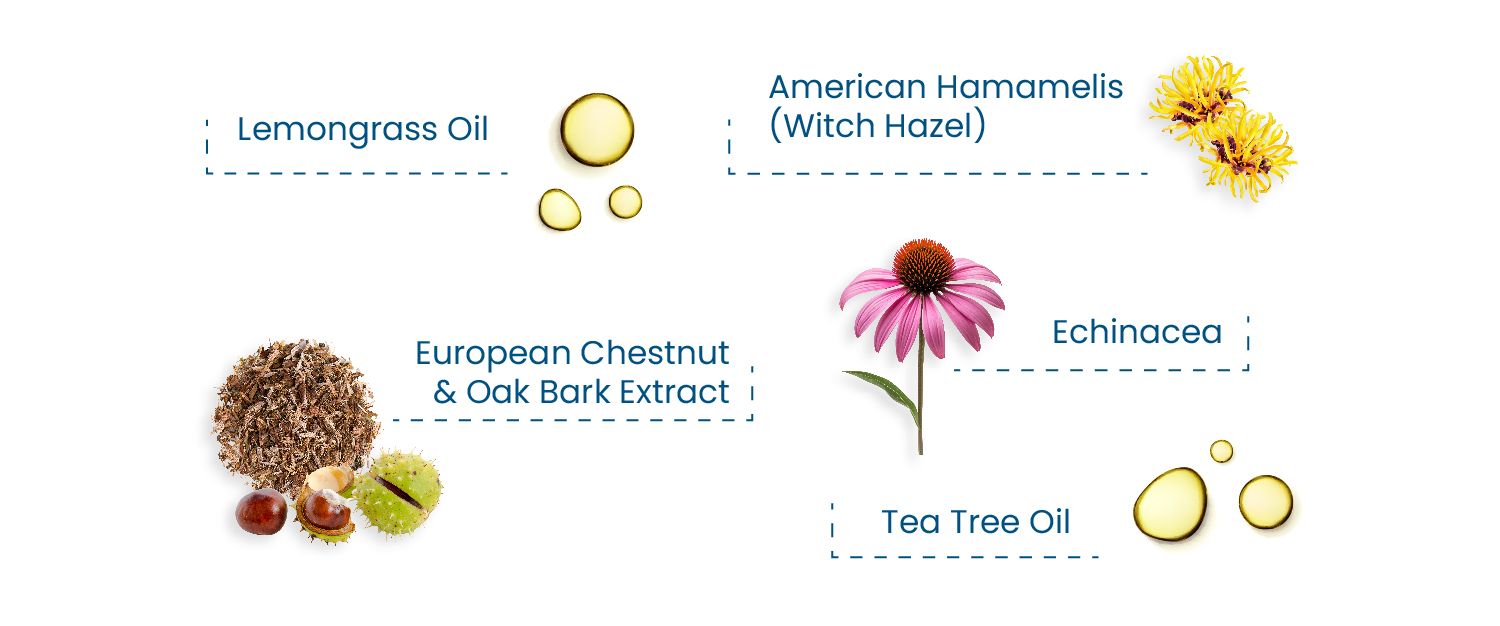
ЕCHINACEA
Soothes itching
https://www.healthline.com/nutrition/echinacea
Echinacea is a group of plants that are rich in antioxidants and may help support immunity. They’re
available in several different forms, which vary in terms of recommended dosage.
Echinacea, also called purple coneflower, is one of the most popular herbs worldwide. Native Americans have
used it for centuries to treat various ailments. Today, it’s best known as an over-the-counter herbal remedy
for the common cold or flu. However, it’s also used to treat pain, inflammation, migraines, and other health
issues.
This herbal ingredient boasts anti-inflammatory properties renowned for their effectiveness in alleviating
inflammation and soothing itching associated with fungal infections.
Both the plant’s upper parts and roots are used in tablets, tinctures, extracts, and teas.
Echinacea plants contain an impressive variety of active compounds, such as caffeic acid, alkamides,
phenolic acids, rosmarinic acid, polyacetylenes, and many more.
Echinacea plants are loaded with plant compounds that function as antioxidants.
Antioxidants are molecules that help defend your cells against oxidative stress, a state that has been
linked to chronic diseases, such as diabetes, heart disease, and many others. Some of these antioxidants are
flavonoids, cichoric acid, and rosmarinic acid. These antioxidants appear to be higher in extracts from the
flowers and roots of the plants, compared to other parts, such as the leaves. In addition, echinacea plants
contain compounds called alkamides, which can further enhance antioxidant activity.
Echinacea also works in a different way to exert antifungal properties. Fungi, including Aspergillus and
Candida, have been studied tirelessly and it has been found that they possess lipoxygenase (LOX) enzymes.
Their LOX is like the ones found in humans. Echinacea exerts its anti-inflammatory nature by inhibiting
these types of enzymes. So, in the presence of LOX enzyme in fungus, Echinacea exhibits the same inhibitory
effect, thus affecting the fungal cell negatively. This makes it more susceptible to the polysaccharide
function of enhancing immunity. Echinacea is a great addition to any formula for immune support and for
antifungal properties.
LEMONGRASS OIL
Fortifies nail texture
https://www.sciencedirect.com/science/article/abs/pii/S1466856407000045
https://www.scielo.br/j/bjid/a/v4Y6YQjVGyzsyYWtgkJ8z6t/
Lemongrass (Cympopogon citratus L.) is a plant in the grass family that contains 1 to 2% essential oil on a dry basis with widely variation of the chemical composition as a function of genetic diversity, habitat and agronomic treatment of the culture (Carlson, Machado, Spricigo, Periera, & Bolzan, 2001). Lemongrass essential oil is characterized by a high content of citral (composed of neural and geranial isomers (c. 69%)), which is used as a raw material for the production of ionone, vitamin A and beta-carotene. Lemongrass is used for treating digestive tract spasms, stomachache, high blood pressure, convulsions, pain, vomiting, cough, achy joints (rheumatism), fever, the common cold, and exhaustion. It is also used to kill germs and as a mild astringent. Its bioactive component citral was previously demonstrated to possess strong antimicrobial efficacy against pathogenic bacteria and fungi. However, their effects on polymicrobial biofilms remain to be determined. Lemongrass oil, with its anti-inflаmmatory properties, treats the discomfort of ingrown toenails and improves nail thickness.
AMERICAN HAMAMELIS
Relieve skin irritations
https://www.ncbi.nlm.nih.gov/pmc/articles/PMC10376399/ Virginian witch hazel (WH; Hamamelis virginiana L.; family: Hamamelidaceae) is a North American plant that is used traditionally to treat a variety of ailments, including bacterial infections. Witch hazel appears to be particularly effective at treating bacterial and fungal infections such as those caused by Staphylococcus Aureus and Candida Albicans and is therefore a useful treatment tool in the battle against microbial skin infections. The herb extract (American Hamamelis) has excellent antiseptic properties which relieve itching, flakiness, and pain.
Tee Tree
Melaleuca alternifolia (tea tree) oil
https://enviromicro-journals.onlinelibrary.wiley.com/doi/10.1046/j.1365-2672.2003.02059.x
https://www.journalijar.com/article/29757/antifungal-activity-of-tea-tree-essential-oils-(melaleuca-alternifolia)-against-phytopathogenic-fungi/
Tea tree oil, also known as melaleuca oil, is an essential oil that comes from steaming the leaves of the
Australian tea tree.
When used topically, tea tree oil is believed to be antibacterial. Tea tree oil is commonly used to
treat acne, athlete's foot, lice, nail fungus and insect bites.
Tea tree oil is available as an oil and in many over-the-counter skin products, including soaps and
lotions.
Deodorizing, hydrating, and relaxing. Effectively combats bad odors and sweating.
Horse Chestnut Extract
https://www.healthline.com/nutrition/horse-chestnut-benefits#TOC_TITLE_HDR_6
https://dergipark.org.tr/en/pub/actabiotr/issue/38830/452463
Horse-chestnut extracts present high antioxidant properties, as well as antibacterial, antimicrobial,
antiviral, and antifungal effects, therefore acting as environmentally biocompatible phototherapeutics.
Horse chestnut extract has powerful anti-inflammatory properties and may help relieve pain and
inflammation. It may also benefit other health conditions like hemorrhoids and male infertility caused by
swollen veins.
Horse chestnut seed extract is rich in flavonoid compounds, including quercetin and kaempferol, which
have potent antioxidant properties.